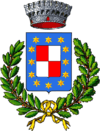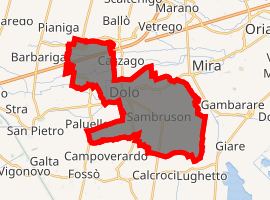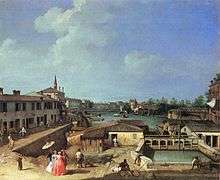Dolo
Dolo is a town and comune in the province of Venice, Veneto, Italy. It is connected by the SP26 provincial road and is one of the towns of the Riviera del Brenta.
Dolo | |
|---|---|
| Comune di Dolo | |
.jpg) San Rocco | |
 Coat of arms | |
Location of Dolo 
| |
 Dolo Location of Dolo in Italy  Dolo Dolo (Veneto) | |
| Coordinates: 45°25′37″N 12°04′31″E | |
| Country | Italy |
| Region | Veneto |
| Metropolitan city | Venice (VE) |
| Frazioni | Arino, Sambruson |
| Government | |
| • Mayor | Alberto Polo |
| Area | |
| • Total | 24.08 km2 (9.30 sq mi) |
| Elevation | 7 m (23 ft) |
| Population (31 December 2010)[2] | |
| • Total | 15,188 |
| • Density | 630/km2 (1,600/sq mi) |
| Demonym(s) | Dolesi |
| Time zone | UTC+1 (CET) |
| • Summer (DST) | UTC+2 (CEST) |
| Postal code | 30031 |
| Dialing code | 041 |
| Patron saint | Saint Roch |
| Saint day | 16 August |
| Website | Official website |
The growth of the town of Dolo is due to the gradual downsizing of the maritime power of Venice which was historically oriented towards Dalmatia, the Aegean Sea and the Middle East, occurred concurrently with the fall of the Byzantine Empire, the Islamic expansion and the new opening of navigation routes to the Americas.
As a consequence Venice had to address inland its new commercial interests.
At the beginning of the fifteenth century, documents testify to the existence of a village which, developing, gave rise to the economic importance of Dolo, always linked to the presence of its water mills collecting wheat from the nearby agricultural lands and then grinding the flour and embarking some into cargo boats pulled by horses along the banks of the Brenta Canal to the lagoon, from where they continued directly up to the Venice island settlement.
Drinking water, too, was carried from Dolo to the center of Venice by cargo boats with big barrels filled directly from springs of the little river Seriola.
The territory was affected by massive hydraulic works that led to the diversion of the main bed of the river Brenta through an artificial canal with new mouths along the southern sea approaches of the port of Chioggia, while just one part of the old Brenta still flows into the lagoon near the location of Fusina.
The purpose of these megalithic hydraulic works was primarily to prevent the progressive flooding of the lagoon by the fresh water of the rivers and thus maintaining a high degree of salinity necessary to make possible the navigation and the very existence of Venice.
Until 1405 the jurisdiction of Dolo was under Padua, and then passed definitely under the dominion of Venice.
A boat called the Burchiello transported Venetian noblemen directly to the Riviera sailing along the river Brenta, which was considered a natural extension of the Grand Canal, to spend summer in their sumptuous villas.
The water level of the navigable river ways were controlled by a system of locks which are nowadays still visible in the center of Dolo, even if the evolution basin is now ground filled.
An old marble table is still on display nearby to show toll tariffs for the transit in the locks for each type of boats coming from or going to Padua.
Close to basin, there is a small shipyard, now dismissed, which was anciently used to repair and shelter the boats prior or after transiting the locks, while laboratories of caulk were housed all around.
The origin of the name of Dolo is quite uncertain and controversial.
One hypothesis asserts the name comes from the contraction of "Dandolo", surname of a noble Venetian family who gave a doge to the city of Venice and had properties here.
From old maps it appears that the town’s name was sometimes reported as Dollo, which in archaic Italian language could also mean a tower which was probably demolished thereafter, unless it refers to the church’s belfry which is the highest in the region of Veneto, second only to St. Mark’s belfry in Venice.
A lovely picture of the ancient locks of Dolo by the Venetian painter Canaletto can be seen in a London museum.

| Wikimedia Commons has media related to Dolo, Veneto. |
Sources
- "Superficie di Comuni Province e Regioni italiane al 9 ottobre 2011". Istat. Retrieved 16 March 2019.
- "Popolazione Residente al 1° Gennaio 2018". Istat. Retrieved 16 March 2019.